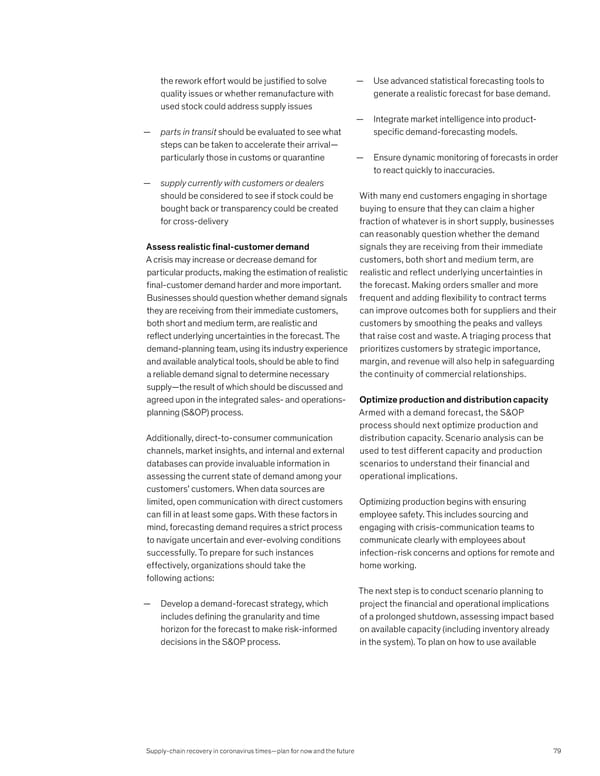the rework effort would be justified to solve — Use advanced statistical forecasting tools to quality issues or whether remanufacture with generate a realistic forecast for base demand. used stock could address supply issues — Integrate market intelligence into product- — parts in transit should be evaluated to see what specific demand-forecasting models. steps can be taken to accelerate their arrival— particularly those in customs or quarantine — Ensure dynamic monitoring of forecasts in order to react quickly to inaccuracies. — supply currently with customers or dealers should be considered to see if stock could be With many end customers engaging in shortage bought back or transparency could be created buying to ensure that they can claim a higher for cross-delivery fraction of whatever is in short supply, businesses can reasonably question whether the demand Assess realistic final-customer demand signals they are receiving from their immediate A crisis may increase or decrease demand for customers, both short and medium term, are particular products, making the estimation of realistic realistic and reflect underlying uncertainties in final-customer demand harder and more important. the forecast. Making orders smaller and more Businesses should question whether demand signals frequent and adding flexibility to contract terms they are receiving from their immediate customers, can improve outcomes both for suppliers and their both short and medium term, are realistic and customers by smoothing the peaks and valleys reflect underlying uncertainties in the forecast. The that raise cost and waste. A triaging process that demand-planning team, using its industry experience prioritizes customers by strategic importance, and available analytical tools, should be able to find margin, and revenue will also help in safeguarding a reliable demand signal to determine necessary the continuity of commercial relationships. supply—the result of which should be discussed and agreed upon in the integrated sales- and operations- Optimize production and distribution capacity planning (S&OP) process. Armed with a demand forecast, the S&OP process should next optimize production and Additionally, direct-to-consumer communication distribution capacity. Scenario analysis can be channels, market insights, and internal and external used to test different capacity and production databases can provide invaluable information in scenarios to understand their financial and assessing the current state of demand among your operational implications. customers’ customers. When data sources are limited, open communication with direct customers Optimizing production begins with ensuring can fill in at least some gaps. With these factors in employee safety. This includes sourcing and mind, forecasting demand requires a strict process engaging with crisis-communication teams to to navigate uncertain and ever-evolving conditions communicate clearly with employees about successfully. To prepare for such instances infection-risk concerns and options for remote and effectively, organizations should take the home working. following actions: The next step is to conduct scenario planning to — Develop a demand-forecast strategy, which project the financial and operational implications includes defining the granularity and time of a prolonged shutdown, assessing impact based horizon for the forecast to make risk-informed on available capacity (including inventory already decisions in the S&OP process. in the system). To plan on how to use available Supply-chain recovery in coronavirus times—plan for now and the future 79
 What Now? Page 80 Page 82
What Now? Page 80 Page 82